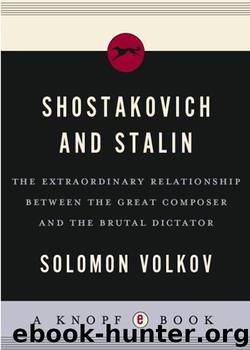Shostakovich and Stalin by Solomon Volkov

Author:Solomon Volkov
Language: eng
Format: epub
Tags: Fiction
ISBN: 9780307427724
Publisher: Knopf Doubleday Publishing Group
Published: 2007-12-18T05:00:00+00:00
In this innermost episode of the symphony, Shostakovich seems to be overcoming personal pain. Here is the parallel with Jesus and with Pushkin, when the poet was dying of the wound he received in a duel. Pushkin supposedly did not want to groan out loud, even though he was in terrible physical pain. “It would be ridiculous for this nonsense to overpower me,” the poet said. “I do not want it.” Shostakovich also used every bit of strength to keep “this nonsense” from overpowering him. As Yevgeny Shvarts, a rather skeptical observer, noted in amazement about the events of 1936, “The nobility of the material from which Shostakovich is created makes one marvel. Real people, whether they want to or not, repay fate with good for evil.”14
Melding the personal and private with the public, Shostakovich created a unique artistic document of the era. Tchaikovsky once called the symphony “a musical confession of the soul.” Shostakovich liked to compare a symphony with a novel. His Fifth was a novel about the dark and confusing 1930s, the likes of which did not appear in the Soviet Union or in the West, for that matter. It was a symphony-novel with several false bottoms. In that way it acquired, in the words of Vladimir Toporov (regarding the works of Akhmatova and Mandelstam, similar in their genesis with Shostakovich’s music), “that status of vagueness and significance that deprives the text of finality and completeness of semantic interpretations and, on the contrary, makes it ‘open,’ existing constantly in statu nascendi and therefore capable of capturing the future, of being adapted to potential situations.”15
The paradox is that the era demanded straightforwardness from artists, but prompted the best of them to create ambivalent images. The audience that gathered at the Leningrad Philharmonic Hall on the night of 21 November 1937 for the premiere of the Fifth Symphony most likely did not appreciate all these artistic subtleties or catch the hidden psychological and political hints. However, there is no doubt that the symphony stunned the public—there are numerous accounts of those who attended. Many wept, a highly unusual reaction to a modern symphony. Intuitively, deeply, the audience understood the symphony’s emotional subtext. One person later compared this premiere with the performance of Tchaikovsky’s Sixth (“Pathétique”) Symphony shortly before the composer’s death; another recalled,“During the finale many listeners involuntarily rose in their places.” 16
By the end of the symphony, the entire audience was standing, applauding wildly through their tears. The young conductor Yevgeny Mravinsky, later to be the first and best performer of many of Shostakovich’s symphonies, responded to the half-hour ovation by raising the score in both hands high above his head to cries of approval. His gesture was provocative in those days.
The artist Lubov Shaporina, a bold and independent observer, had been at the Philharmonic on that historic evening, and she wrote in her diary that the tumultuous ovations were a demonstration against the official persecution of Shostakovich. “Everyone kept saying the same thing: He responded and he responded well.
Download
This site does not store any files on its server. We only index and link to content provided by other sites. Please contact the content providers to delete copyright contents if any and email us, we'll remove relevant links or contents immediately.
Cecilia; Or, Memoirs of an Heiress — Volume 3 by Fanny Burney(30938)
Cecilia; Or, Memoirs of an Heiress — Volume 2 by Fanny Burney(30896)
Fanny Burney by Claire Harman(25789)
We're Going to Need More Wine by Gabrielle Union(18081)
Plagued by Fire by Paul Hendrickson(16641)
Cat's cradle by Kurt Vonnegut(13879)
Bombshells: Glamour Girls of a Lifetime by Sullivan Steve(13117)
All the Missing Girls by Megan Miranda(12761)
Leonardo da Vinci by Walter Isaacson(11913)
4 3 2 1: A Novel by Paul Auster(11064)
Adultolescence by Gabbie Hanna(8151)
The remains of the day by Kazuo Ishiguro(7565)
Note to Self by Connor Franta(7029)
Diary of a Player by Brad Paisley(6870)
Giovanni's Room by James Baldwin(5889)
What Does This Button Do? by Bruce Dickinson(5533)
Recovery by Russell Brand(4571)
Born a Crime by Trevor Noah(4517)
The Kite Runner by Khaled Hosseini(4463)
